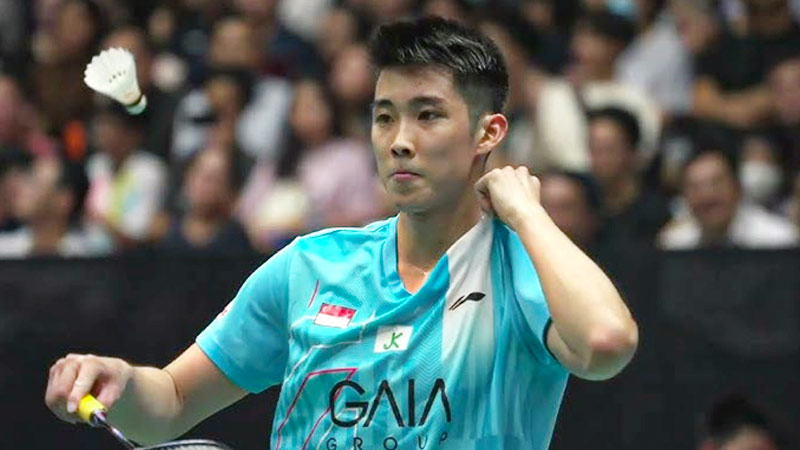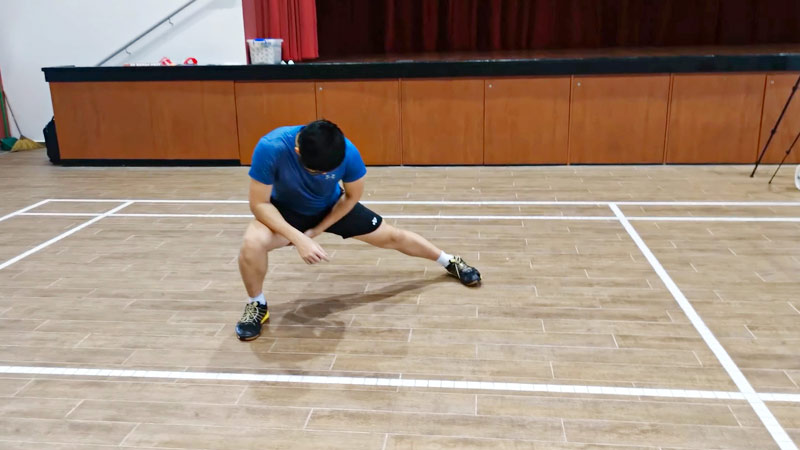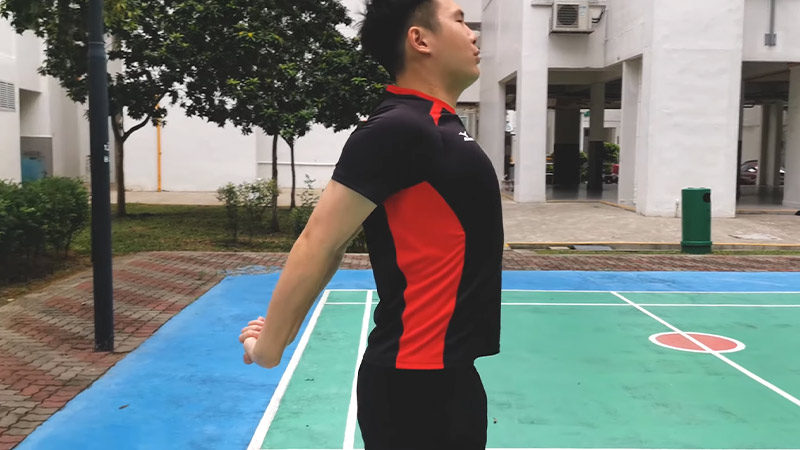Exhilarating rallies, precise shots, and swift movements characterize the dynamic game of badminton. However, the aftermath might reveal an unwelcome companion: shoulder pain.
This discomfort of shoulder hurts after badminton often arises due to the repetitive, high-intensity nature of the game, impacting players of all levels.
Understanding the causes behind this shoulder pain is crucial for players seeking solutions to continue enjoying the sport pain-free.
From overexertion to improper techniques, various factors contribute to these aches. Exploring these reasons and identifying preventive strategies can pave the way for a more sustainable and injury-free badminton experience.
Why Does My Shoulder Hurt After Playing Badminton?
Shoulder pain after playing badminton can stem from various causes. The repetitive overhead motion in badminton, especially while smashing or serving, strains the rotator cuff muscles and tendons, leading to discomfort or injury.
Incorrect technique, sudden movements, or overexertion without proper warm-up may also contribute to the pain. Additionally, poor posture or lack of conditioning could strain the shoulder muscles, causing discomfort.
It’s crucial to assess your playing technique, ensure proper warm-up exercises, and consider strengthening exercises for the shoulder muscles to prevent such discomfort.
If the pain persists or intensifies, seeking professional medical advice is essential to address any potential injuries and receive appropriate treatment.
Common Causes of Shoulder Pain After Badminton
Certainly, shoulder pain in badminton often arises from several factors related to the sport’s demands and the body’s response to these stresses. Here are some common causes explained in detail:
- Repetitive Overhead Movements: The constant overhead swinging in badminton, particularly during powerful shots like smashes and serves, strains the shoulder’s rotator cuff muscles and tendons.
- Incorrect Technique: Improper form or technique while executing shots can lead to excessive stress on the shoulder joint, causing discomfort or injury.
- Sudden or Excessive Movements: Abrupt movements or overexertion without an adequate warm-up can strain the shoulder muscles, leading to pain.
- Poor Posture: Maintaining incorrect posture during play can put undue stress on the shoulder, resulting in muscle strain and discomfort.
- Lack of Conditioning: Inadequate conditioning and strength in the shoulder muscles could make them more susceptible to strain and injury during play.
Recognizing these potential causes can help in adjusting technique, incorporating proper warm-up routines, and focusing on shoulder-strengthening exercises to prevent and alleviate post-badminton shoulder pain.
Seeking professional guidance for persistent or severe pain is crucial for proper diagnosis and treatment.
Signs and Symptoms of Shoulder Pain from Badminton

Badminton shoulder pain can manifest in various signs and symptoms, often indicating strain or injury. Understanding these indicators is crucial for timely intervention and injury prevention.
Dull or Sharp Pain
Players might experience a persistent, dull ache or sharp, shooting pain in the shoulder region, particularly during or after playing. This discomfort can range from mild to severe, affecting mobility.
Limited Range of Motion
Difficulty in raising the arm or moving it in certain directions is common. This limitation in the shoulder’s range of motion can hinder gameplay and everyday activities.
Weakness or Instability
Weakness or a feeling of instability in the shoulder could occur, affecting the ability to perform certain badminton movements. This can lead to a decreased ability to control the arm during gameplay.
Swelling or Inflammation
Swelling around the shoulder joint might be noticeable, accompanied by redness or warmth in the affected area. Inflammation could contribute to the discomfort.
Clicking or Popping Sensation
Players might experience unusual sensations like clicking or popping in the shoulder joint during movement. This could signal issues within the joint, such as tendon irritation or instability.
Persistent Discomfort
Shoulder pain that doesn’t subside even with rest or mild activity could indicate a more severe issue. Persistent discomfort, especially if it worsens, should prompt immediate attention.
Recognizing these signs and symptoms is pivotal in addressing shoulder issues early on. Rest, proper stretching, and strengthening exercises specific to the shoulder muscles can aid in recovery and prevent further complications.
However, if the symptoms persist or worsen, seeking a professional medical assessment is crucial to diagnose the problem accurately and initiate appropriate treatment, preventing potential long-term damage.
Preventive Measures for Badminton Rotator Cuff Injury
Preventing rotator cuff injuries in badminton involves a combination of proactive measures aimed at strengthening, proper technique, and smart gameplay strategies.
Here are some preventive measures:
Proper Warm-up

Prior to playing, engage in a thorough warm-up routine that includes shoulder-specific stretches and mobility exercises. This helps prepare the muscles and joints for the game’s demands.
Technique Refinement
Ensure you learn and practice correct techniques for various badminton strokes. Seek guidance from a coach to perfect your form, especially for overhead shots, to reduce strain on the rotator cuff.
Strength and Flexibility Training
Incorporate shoulder-strengthening exercises into your fitness regimen. Focus on exercises targeting the rotator cuff muscles, such as external and internal rotations, to improve strength and stability.
Additionally, overall body conditioning exercises contribute to better support for the shoulders.
Balanced Gameplay
Avoid overexertion and excessive repetition of certain strokes. Balance your gameplay to distribute the stress on the shoulders more evenly.
Rest and Recovery
Allow ample time for rest between matches or training sessions. Recovery periods are crucial for muscle repair and injury prevention.
Proper Equipment and Attire
Ensure you’re using the right equipment, such as a racket with an appropriate grip size, to minimize strain on the shoulders. Wearing supportive gear like a shoulder brace can also help prevent injuries.
Listen to Your Body
Pay attention to any warning signs or discomfort. Ignoring initial signs of strain can lead to more severe injuries. If you feel persistent discomfort, give yourself time to rest and, if needed, seek professional advice.
By implementing these preventive measures, you can significantly reduce the risk of rotator cuff injuries in badminton, allowing you to enjoy the game while minimizing the chances of shoulder-related issues.
Seeking Professional Help for Shoulder Pain Due to Badminton
Seeking professional help for shoulder pain resulting from badminton is crucial to accurately diagnose the issue and receive appropriate treatment. Here’s a guide on how to approach this:
Consult a Physician or Orthopedic Specialist

Begin by visiting a general physician or an orthopedic specialist.
They can conduct a comprehensive examination, assessing the severity of the injury and potentially ordering imaging tests like X-rays or MRI scans to understand the extent of the damage.
Expert Guidance
Consider consulting a physical therapist or a sports medicine professional who specializes in shoulder injuries. They can provide tailored exercises and rehabilitation programs to strengthen the shoulder and facilitate recovery.
Treatment Plan
Based on the diagnosis, the professional can suggest a treatment plan, which might involve a combination of rest, physical therapy, anti-inflammatory medications, or, in more severe cases, surgical intervention.
Rehabilitation Program
If needed, the professional can create a structured rehabilitation program. This may include exercises to improve flexibility, strength, and stability in the shoulder joint, gradually reintroducing activities to prevent re-injury.
Preventive Measures
Professionals can also offer guidance on preventive measures, including proper warm-up routines, technique refinement, and lifestyle adjustments to reduce the risk of future shoulder injuries.
Follow-up Appointments
It’s essential to attend follow-up appointments to track progress and make any necessary adjustments to the treatment plan. This helps ensure that the shoulder heals properly and that you’re on the right track to recovery.
Patience and Compliance
Recovery from shoulder injuries takes time. It’s crucial to be patient and follow the professional’s advice diligently. Consistency in following the recommended exercises and treatment plan is key to a successful recovery.
By seeking professional help, individuals can address their shoulder issues effectively, and take necessary steps to prevent future injuries, ensuring a safer and more sustainable return to badminton or any physical activity.
FAQs
Is shoulder pain while playing badminton normal?
Shoulder pain during or after playing badminton is not uncommon. It can result from overuse, improper technique, or muscle strain.
Players often use repetitive overhead motions, and if the muscles are not adequately conditioned, it can lead to discomfort.
Why does shoulder pain occur after a badminton smash?
The powerful and rapid motion involved in executing a badminton smash can strain the shoulder muscles and joints. Incorrect form, overexertion, or lack of warm-up may contribute.
The impact of the forceful smash can lead to muscle soreness and potential injury.
How to deal with shoulder pain after a badminton smash?
Firstly, rest is crucial to allow the shoulder to recover. Applying ice to the affected area can help reduce inflammation. Gentle stretching and strengthening exercises for the shoulder muscles can aid in rehabilitation.
If pain persists, seeking professional guidance, such as a physiotherapist, is advisable.
Can poor technique cause shoulder pain in badminton?
Yes, poor technique is a common contributor to shoulder pain in badminton. Incorrect body positioning, improper grip, or faulty swing mechanics can place excessive stress on the shoulder joint and surrounding muscles.
Ensuring proper coaching and technique refinement can prevent and alleviate such issues.
Are there preventive measures for shoulder pain in badminton?
Yes, several preventive measures can help minimize shoulder pain in badminton. Adequate warm-up before playing, including specific shoulder stretches, can improve flexibility.
Strengthening exercises for the shoulder and upper back muscles can enhance stability. Using proper equipment, such as a suitable racket and string tension, is also essential for injury prevention.
Wrapping Up
“Shoulder pain following a badminton match isn’t uncommon, but it need not be a permanent setback.
By delving into the triggers and adopting preventive measures, players can mitigate these issues and relish the game without the ache.
Seeking professional guidance, refining techniques, and embracing a comprehensive approach to shoulder health can transform the game into a pain-free, exhilarating experience.
Understanding the why behind the pain empowers players to implement effective solutions, ensuring the joy of badminton remains untarnished by shoulder discomfort.”







